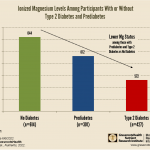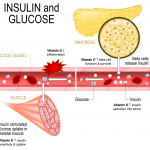Published on February 5, 2024
A new study confirms systemic inflammation as a major pathway between stress and metabolic dysfunction development and severity
Key Points
- Having at least three of the following risk factors could indicate metabolic syndrome: high blood pressure, high blood sugar, high triglyceride levels, low HDL cholesterol levels, and excess body fat around the waist
- A new study investigating the connection between stress and metabolic syndrome found a small but significant direct effect of perceived stress on metabolic syndrome, such that higher appraisals of stress were associated with greater metabolic dysregulation. They also found a significant indirect effect of increased stress on systemic inflammation and elevated inflammation markers, which in turn was associated with greater metabolic dysregulation; this particular effect accounted for 61.5% of the variance in the relationship between perceived stress and metabolic syndrome.
- Omega-3, magnesium, and vitamin D status have each also been associated with the development of metabolic syndrome
 Metabolic syndrome (also known as insulin resistance syndrome) is a group of risk factors that occur together to increase your risk of, or even help predict a future diagnosis of, cardiovascular disease, type 2 diabetes, neurodegeneration, and the onset and progression of dementia and Alzheimer’s disease. Having at least three of the following risk factors could indicate metabolic syndrome: high blood pressure, high blood sugar, high triglyceride levels, low HDL cholesterol levels, and excess body fat around the waist.
Metabolic syndrome (also known as insulin resistance syndrome) is a group of risk factors that occur together to increase your risk of, or even help predict a future diagnosis of, cardiovascular disease, type 2 diabetes, neurodegeneration, and the onset and progression of dementia and Alzheimer’s disease. Having at least three of the following risk factors could indicate metabolic syndrome: high blood pressure, high blood sugar, high triglyceride levels, low HDL cholesterol levels, and excess body fat around the waist.
Could Chronic Stress Cause Metabolic Syndrome?
One of the identified risk factors for metabolic syndrome is psychological or perceived stress. Chronic stress can induce systemic inflammation and alter inflammatory activity, which in turn can contribute to the development and severity of metabolic syndrome. Chronic stress has also been linked to elevated levels of inflammatory markers including interleukin-6 (IL-6) and C-reactive protein (CRP). In fact, several studies have shown that those under high amounts of work-related stress also had a higher risk of elevated CRP levels, which in turn were related to an increased risk of metabolic syndrome. However, this was one of only a few studies that have looked at the specific relationship between stress, inflammation, and metabolic syndrome.
A study by Jurgens et al. aimed to confirm systemic inflammation as a pathway linking perceived stress and metabolic syndrome. Using a set of data from 648 mid-to-late life adults (average age of 52 years) living in the United States, the authors analyzed biomarkers of inflammation and metabolic health and compared those to their measures of perceived stress.
The authors found a small but significant direct effect of perceived stress on metabolic syndrome, such that higher appraisals of stress were associated with greater metabolic dysregulation. They also found a significant indirect effect of increased stress on systemic inflammation and elevated inflammation markers, which in turn was associated with greater metabolic dysregulation; this particular effect accounted for 61.5% of the variance in the relationship between perceived stress and metabolic syndrome, meaning that inflammation was confirmed as the link between stress and metabolic syndrome in more than half of the cases.
As the authors conclude,
“Our findings suggest that stress can contribute to a state of chronic, low-grade inflammation that leads to metabolic dysregulation. These results underscore the importance of understanding the inflammatory consequences of stress and implications for metabolic health. Stress-reduction techniques may serve as cost-effective interventions for preventing and treating metabolic disease.”
Check Out the Following Related Posts and Studies
Could Increasing Your Omega 3 Status Help Maintain a Healthy Weight and Mood?
 Omega-3s have been shown to reduce levels of inflammation and help regulate metabolic dysfunction. Studies have also shown that omega-3s may help to improve body composition and weight, with increased omega-3s linked to reduced body weight, fat mass, and waist circumference. Read More
Omega-3s have been shown to reduce levels of inflammation and help regulate metabolic dysfunction. Studies have also shown that omega-3s may help to improve body composition and weight, with increased omega-3s linked to reduced body weight, fat mass, and waist circumference. Read More
Magnesium Status and Body Fat Measurements Shown to be Significantly Related
 Study finds a significant association between serum magnesium and metabolic syndrome, which is characterized by a combination of elevated waist circumference, high blood pressure, low HDL cholesterol, high triglycerides, and/or elevated fasting glucose; this is not surprising, as magnesium is necessary for several important processes involved with glucose and insulin metabolism. Read More
Study finds a significant association between serum magnesium and metabolic syndrome, which is characterized by a combination of elevated waist circumference, high blood pressure, low HDL cholesterol, high triglycerides, and/or elevated fasting glucose; this is not surprising, as magnesium is necessary for several important processes involved with glucose and insulin metabolism. Read More
New Meta-analysis Shows Significant Effect of Vitamin D on Regulating Insulin Resistance
 Studies have shown that the risk of developing insulin resistance and/or diabetes over time increases with lower vitamin D levels. Because of this observation, Lei et al. recently completed a meta-analysis of 18 randomized controlled trials (RCTs) and 20 observational studies to more clearly define the relationship between vitamin D, insulin resistance, and type 2 diabetes. Read More
Studies have shown that the risk of developing insulin resistance and/or diabetes over time increases with lower vitamin D levels. Because of this observation, Lei et al. recently completed a meta-analysis of 18 randomized controlled trials (RCTs) and 20 observational studies to more clearly define the relationship between vitamin D, insulin resistance, and type 2 diabetes. Read More
How Are Your Levels of Omega-3s, Magnesium, Vitamin D and CRP?
The Omega-3 Index measures the amount of EPA and DHA in your blood and tissues. Do you know what your Omega-3 Index is? Check yours along with your vitamin D and magnesium levels today as part of the vitamin D*action project, and add the Ratios for more about how to balance your Omega-3s and 6s!
Measure your:
- Vitamin D
- Magnesium PLUS Elements
- Omega-3 Fatty Acids
- hsCRP (for Inflammation)
- HbA1c (for Blood Sugar)
- and more
Did you know that each of the above can be measured at home using a simple blood spot test? As part of our ongoing research project, you can order your home blood spot test kit to get your levels, followed by education and steps to take to help you reach your optimal target levels. Start by enrolling and ordering your kit to measure each of the above important markers, and make sure you are getting enough of each to support better mood and wellbeing!
Build your custom kit here – be sure to include your Omega-3 Index along with your vitamin D.
Start Here to Measure Your Levels






